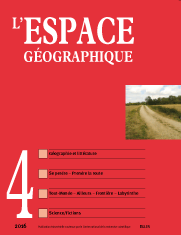

Literary spatiality as seen through the lens of geography
Épépé. A case study in experimental geography
Of what interest are novels to geographical science? Using the novel, Épépé, by the Hungarian writer Ferenc Karinthy, we will demonstrate that even though novels can inform geographical knowledge, it is the spatial characteristics of fictional situations that are of particular interest. Every novel represents referential spaces and spatialities. The plot of Épépé unfolds in a mysterious town and refers to a nostalgic space. The novel’s hero, Budai, does not know where he is and deploys various strategies in order to find out. He has no other choice than to live in the town from which he wants to escape. This improbable situation is a form of spatial experience that draws on geographical knowledges. Within an extreme context, it brings into play spatial and spatialized concepts: (dis)orientation, communication, inhabitation.
keywords: FICTION, INDIVIDUAL, SENSITIVE GEOGRAPHY, SPACE OF REFERENCE, SPATIALITY
The experience of borderlands in three novels of the Communist era (Josef Jedlička, Bouhumil Hrabal and Jaroslav Durych)
This article explores how Bohemian borderlands are represented in three Czech language novels during the Communist era: I served the King of England by Bohumil Hrabal, God’s Rainbow by Jaroslav Durych, and In the Midway of this Our Mortal Life by Josef Jedlička. How are border specific experiences depicted in literature? All three works are characterized by discontinuity, uprooting, and marginality. These characteristics are determinant both geographically and for their dramatic and symbolic functions within each narrative.
keywords: BORDER, LAND, NARRATIVE, SITUATION
Edouard Glissant’s geopoetics, a contribution to the idea of the world as the World
Throughout his work, Edouard Glissant developed a vision of the world by exploring concepts such as the Whole-world and the Place, creolization and digenesis, Relationship and diversity, the archipelago and the continent. Through an analysis of several of his essays, we can see how he has contributed to the modern debate, in the realm of the social sciences, on a controversial and ill-defined reality that crosses over disciplinary borders. By mobilizing texts that narrate a singular experience and vision of the world, texts that are more interested in creating a poetics than a theory of “mondialité” or Worldmentality, we hope to shine a new light on the conception of the world as the World.
keywords: GEO-LITERARY, GEOPOETIC, GLISSANT, MONDIALITÉ
The transformations of Milan in the gaze of Italian contemporary poets
The works of Milanese poets, from the “Lombard line” to “young Italian contemporary poetry” display a remarkable commitment to Milan and attention to the changes that the city has known in recent decades. The testimony of these writers contributes to the geographical understanding of urban territory.
keywords: GEOGRAPHY, MILAN, POETRY, URBAN TRANSFORMATION
The province and elsewhere. Paolo Conte’s songs as a way to conceptualize space (2 encadrés)
Paolo Conte is one of Italy’s greatest contemporary singer-songwriters. His work is deeply rooted in the Po valley of the Post World War II. His poetics also use more exotic geographical references from South America to Zanzibar, as part of an allegorical displacement. This artistic strategy allows Conte to impart broader, even universal, impact to ordinary stories. His spatial conception revolves around two intertwined geographic archetypes: the province and elsewhere. The former is made of haze and boredom, whereas the latter is a promise of happiness and an escape into the exotic.
keywords: EXOTICISM, LANDSCAPE, PROVINCE, SONGS, TERRITORY
The map and the text; a geographer’s reading of “Wandering Rocks” (Ulysses, chapter 10)(1 encadré)
James Joyce’s Ulysses is deeply linked to the geographical reality of Dublin. Yet, aside from street names, the text offers up very few topographical details. A study of chapter 10, the most city-centered of the book, shows how mapping and writing are related. This chapter is made of separate narrative fragments, and can’t be fully understood by reading them in sequence. Different places are shown simultaneously, as when viewing a map, thus highlighting the differences between grasping a place through a map and through a literary description.
keywords: DUBLIN, JAMES JOYCE, LITERATURE, MAPPING, ULYSSES
Julien Gracq’s Les Terres du couchant. Sedentary vs nomadic empires
In 2014, Editions José Corti published Gracq's (1910-2007) novel Les Terres du couchant (Sunset Lands). The text gives access to the making of Gracq’s writing. Readers were already familiar with La Route (The Road), an excerpt Gracq had chosen to publish, taken from his 500 pages manuscript. He had started his narrative project around 1954; but never finished. Les Terres du couchant show us where La Route came from and where it was going. The events told by the narrator are characteristic of Gracq’s poetics, exploring the seemingly academic phrase: historygeography. The historical component is the decline of a kingdom threatened by a wave of invasions and the geographic one is a territory long held within the diversity of its landscape. The narrative is oriented from the sunset in the west to the sunrise in the east and the uncompleted manuscript suspends any conclusive event. Julien Gracq’s imaginary draws on literary references, but also on fragments of scholarly culture.
keywords: JULIEN GRACQ, HISTORY-GEOGRAPHY, LITERATURE, POETIC NARRATIVE, TERRITORIAL IMAGINATION
Book reviews
In this issue of l’Espace géographique, you will find critical reviews of the following books
Chartier D., Rodary E. (dir.)(2016). Manifeste pour une géographie environnementale. Paris: Les Presses de Sciences Po, 440 p. (Yves Guermond, université de Rouen, Umr IDEES) et (Yanni Gunnell, université Lumière-Lyon 2) ISBN: 978-2-7246-1840-2
L’espace géographique 3/16![]()
![]() L’espace géographique 1/17
L’espace géographique 1/17
For subscribe or buy this issue: BELIN
![]() L’Espace géographique: contents
L’Espace géographique: contents
Last modified: October 26, 2016